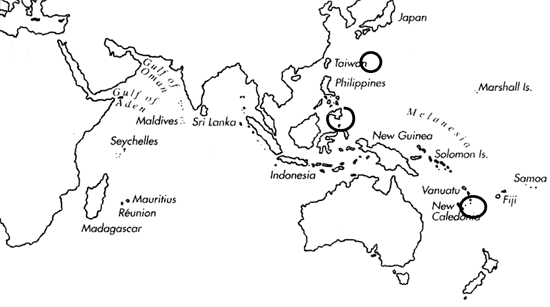Range: Known from Loyalty Is., Kita-Koho area (Philippine Sea, 26┬░ 46' N, 135┬░ 22' E), and Philippines (Balut Is.).
Description: Moderately large to large, moderately solid. Last whorl slightly pyriform, outline convex at adapical third and slightly concave below. Shoulder subangulate, marked by a spiral groove just below shoulder edge, producing a keeled appearance. Spire of moderate height or high, stepped; outline straight to slightly concave. Larval shell of about 3.5 whorls, maximum diameter about 1.1 mm. Specimens of 51 mm with 11 postnuclear whorls, the first 9-10 tuberculate. Teleoconch sutural ramps flat to slightly concave, with 1 increasing to 3-5 weak spiral grooves. Last whorl with about 15 weak spiral ribs near base.
| Shell Morphometry | ||
|---|---|---|
| L | 51-87 mm | |
| RW | 0.12-0.33 g/mm | |
| RD | 0.52-0.59 | |
| PMD | 0.83-0.89 | |
| RSH | 0.20-0.30 | |
Ground colour white. Last whorl with dark reddish brown axial flames from base to shoulder, extending onto shoulder ramp. Flames connected spirally at base and at each side of the central area. Larval whorls white. Early postnuclear whorls with a brown subsutural ridge and brown tubercles. Later sutural ramps with dark reddish brown radial blotches. Aperture white.
Periostracum yellowish brown, thin, translucent, smooth.
Habitat and Habits: Deep subtidal. Kita-koho area: In about 325 m (Darkin, pers. comm., 1991); Balut Id.: In 280-300 m on rocky and muddy bottom (Guillot de Suduiraut, pers. comm., 1992); Loyalty Is.: In 575 m (holotype) and in 480 m (paratype 1).
Discussion: C. darkini is a distinctive member within the group of species, of which C. smirna was the first described. The large number of strongly tuberculate spire whorls, the keeled appearance of the shoulder and the brown colour of the subsutural ridge and tubercles in the early postnuclear whorls distinguishes it from all the other members. The multispiral larval shell of C. darkini differs from C. ikedai and C. scopulicola (3.5 vs. 2 whorls). C. ikedai differs in colour pattern, while C. scopulicola differs in arrangement of the spiral colour bands (third band below shoulder instead of at base). Typical C. smirna also differs in the absence of axial pattern elements and the smaller number of postnuclear whorls in similar sized specimens (8-9 vs. 11 ) . The shells from New Caledonia assigned to C. smirna are also distinguished by their narrower last whorl (RD 0.49-0.53), and those from the New Zealand area by their higher spire (RSH 0.25-0.30). C. profundorum can be distinguished by its rounded shoulder, the brown shades within its aperture and the primarily spiral arrangement of its last whorl pattern. C. lani has a last whorl with straight outline, and brown colouration with scattered white spots.

C. darkini range map
This section contains verbatim reproductions of the accounts of 316 species of Conus from the Indo-Pacific region, from Manual of the Living Conidae, by R÷ckel, Korn and Kohn (1995). They are reproduced with the kind permission of the present publisher, Conchbooks.
All plates and figures referred to in the text are also in R÷ckel, Korn & Kohn, 1995. Manual of the Living Conidae Vol. 1: Indo-Pacific Region.
The range maps have been modified so that each species account has it own map, rather than one map that showed the ranges of several species in the original work. This was necessary because each species account is on a separate page on the website and not confined to the order of accounts in the book.